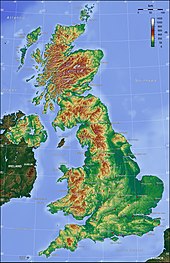Geography
The total area of the United Kingdom is approximately 244,820 square kilometres (94,530 sq mi). The country occupies the major part of the British Isles[138] archipelago and includes the island of Great Britain, the north-eastern one-sixth of the island of Ireland and some smaller surrounding islands. It lies between the North Atlantic Ocean and the North Sea with the south-east coast coming within 22 miles (35 km) of the coast of northern France, from which it is separated by the English Channel.[139] In 1993 10 per cent of the UK was forested, 46 per cent used for pastures and 25 per cent cultivated for agriculture.[140] The Royal Greenwich Observatory in London was chosen as the defining point of the Prime Meridian[141] in Washington in 1884, though it no longer is.[142]
The United Kingdom lies between latitudes 49° and 61° N, and longitudes 9° W and 2° E. Northern Ireland shares a 224-mile (360 km) land boundary with the Republic of Ireland.[139] The coastline of Great Britain is 11,073 miles (17,820 km) long.[143] It is connected to continental Europe by the Channel Tunnel, which at 31 miles (50 km) (24 miles (38 km) underwater) is the longest underwater tunnel in the world.[144]
England accounts for just over half (53 per cent) of the total area of the UK, covering 130,395 square kilometres (50,350 sq mi).[145] Most of the country consists of lowland terrain,[140] with mountainous terrain north-west of the Tees-Exe line; including the Cumbrian Mountains of the Lake District, the Pennines, Exmoor and Dartmoor. The main rivers and estuaries are the Thames, Severn and the Humber. England's highest mountain is Scafell Pike (978 metres (3,209 ft)) in the Lake District.
Scotland accounts for just under a third (32 per cent) of the total area of the UK, covering 78,772 square kilometres (30,410 sq mi).[146] This includes nearly eight hundred islands,[147] predominantly west and north of the mainland; notably the Hebrides, Orkney Islands and Shetland Islands. Scotland is the most mountainous country in the UK and its topography is distinguished by the Highland Boundary Fault – a geological rock fracture – which traverses Scotland from Arran in the west to Stonehaven in the east.[148] The fault separates two distinctively different regions; namely the Highlands to the north and west and the Lowlands to the south and east. The more rugged Highland region contains the majority of Scotland's mountainous land, including Ben Nevis which at 1,345 metres (4,413 ft)[149] is the highest point in the British Isles.[150] Lowland areas – especially the narrow waist of land between the Firth of Clyde and the Firth of Forth known as the Central Belt – are flatter and home to most of the population including Glasgow, Scotland's largest city, and Edinburgh, its capital and political centre, although upland and mountainous terrain lies within the Southern Uplands.
Wales accounts for less than a tenth (9 per cent) of the total area of the UK, covering 20,779 square kilometres (8,020 sq mi).[151] Wales is mostly mountainous, though South Wales is less mountainous than North and mid Wales. The main population and industrial areas are in South Wales, consisting of the coastal cities of Cardiff, Swansea and Newport, and the South Wales Valleys to their north. The highest mountains in Wales are in Snowdonia and include Snowdon (Welsh: Yr Wyddfa) which, at 1,085 metres (3,560 ft), is the highest peak in Wales.[140] Wales has over 2,704 kilometres (1,680 miles) of coastline.[143] Several islands lie off the Welsh mainland, the largest of which is Anglesey (Ynys Môn) in the north-west.
Northern Ireland, separated from Great Britain by the Irish Sea and North Channel, has an area of 14,160 square kilometres (5,470 sq mi) and is mostly hilly. It includes Lough Neagh which, at 388 square kilometres (150 sq mi), is the largest lake in the British Isles by area.[152] The highest peak in Northern Ireland is Slieve Donard in the Mourne Mountains at 852 metres (2,795 ft).[140]
Climate
Most of the United Kingdom has a temperate climate, with generally cool temperatures and plentiful rainfall all year round.[139] The temperature varies with the seasons seldom dropping below −20 °C (−4 °F) or rising above 35 °C (95 °F).[153][154] Some parts of upland England, Wales and Northern Ireland as well as most of Scotland, away from the coast, experiences a Subpolar oceanic climate (Cfc). Higher elevations in Scotland experience a continental Subarctic climate (Dfc) and the mountains experience a Tundra climate (ET).[155] The prevailing wind is from the south-west and bears frequent spells of mild and wet weather from the Atlantic Ocean,[139] although the eastern parts are mostly sheltered from this wind since the majority of the rain falls over the western regions the eastern parts are therefore the driest. Atlantic currents, warmed by the Gulf Stream, bring mild winters;[156] especially in the west where winters are wet and even more so over high ground. Summers are warmest in the south-east of England, being closest to the European mainland, and coolest in the north. Heavy snowfall can occur in winter and early spring on high ground, and occasionally settles to great depth away from the hills.
https://en.wikipedia.org/wiki/United_Kingdom
https://en.wikipedia.org/wiki/United_Kingdom



No comments:
Post a Comment